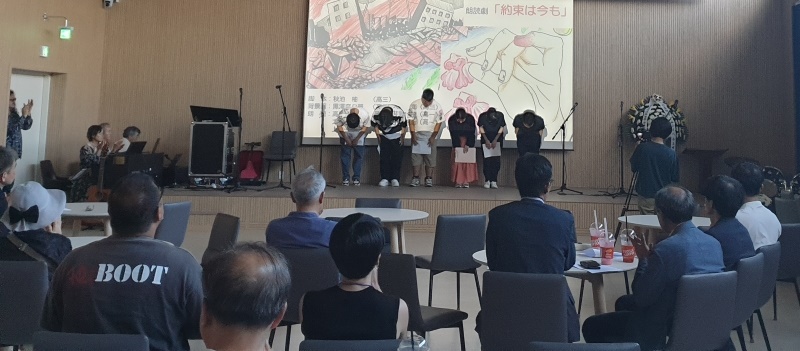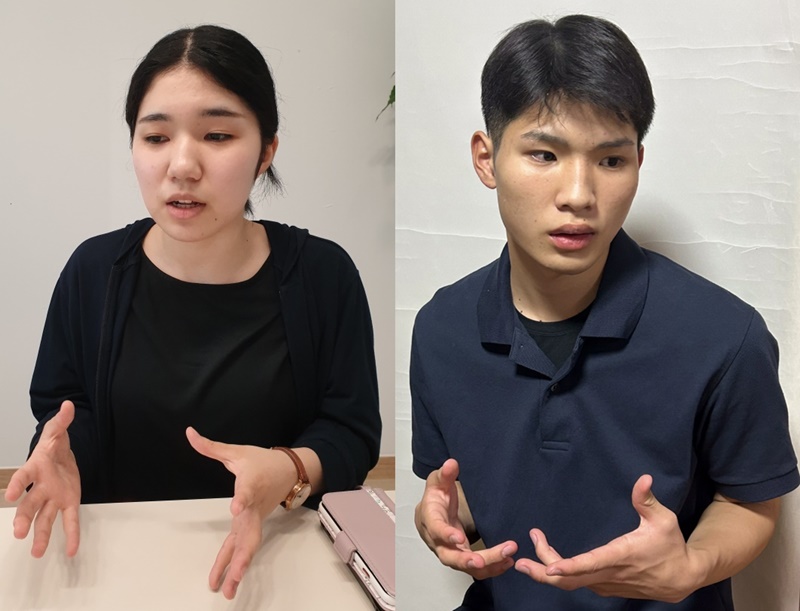
Six Japanese students on Aug. 25 bow to the audience after performing a reader's theater work on the massacre of ethnic Korean residents of Japan after the massive Kanto earthquake in 1923 at the 1923 History Museum for Memory and Peace in Cheonan, Chungcheongnam-do Province.
By Koh Hyunjeong
Photos = Koh Hyunjeong
"Behind the 1923 Kanto earthquake, which harmed countless people, is another tragic story of numerous Koreans who lost their lives due to groundless rumors. It's never acceptable to commit violence based on false rumors."
This is what six Japanese students said on Aug. 25 while performing the reader's theater work "Promise Even Now" at the 1923 History Museum for Memory and Peace in Cheonan, Chungcheongnam-do Province, a week before the centennial anniversary of the earthquake.
The work depicted the real-life friendship between Kikuchiro Miyazawa and Gu Hak-yeong, an ethnic Korean resident of Japan. Miyazawa built a tombstone for Goo, who was killed by an angry mob shortly after the disaster.
The reader's theater play on Aug. 1 was performed under the same theme in the Japanese city of Saitama in the Greater Tokyo area.
After the magnitude-7.9 earthquake at 11:58 a.m. on Sept. 1, 1923, devastated the Kanto region that includes Tokyo, false rumors spread that ethnic Korean residents in the area committed arson and poisoned the water in wells, resulting in massacres of thousands of them.
Six Japanese students -- Tsunagu Kamijo, Raito Kobayashi, Takuru Ino, Akiri Takahira, Nanami Ohama and Hiromi Ohama -- made their first visits to Korea to raise awareness of these killings. The students who wrote the script and drew the illustrations could not attend due to personal circumstances.
Korea.net covered the event and ahead of its opening, held interviews with Takahira, the only one of the six students to perform in the work in Korea and Japan, and Hiromi Ohama, who played Gu.

Japanese students Akari Takahira (left) and Hiromi Ohama (right) on Aug. 25 give interviews to Korea.net before appearing in the reader's theater work "Promise Even Now" at the 1923 History Museum for Memory and Peace in Cheonan, Chungcheongnam-do Province. Takahira said she was very interested in peace among humanity while Ohama said he never hesitated to take part in the project.
How did you get involved in this reader's theater work?
Takahira: I first learned of the massacre of ethnic Korean residents after the Kanto earthquake when I read the Japanese-language edition of the book "Yeot (traditional taffy) Merchant Gu Hak-yeong." The book at the time was not readily available at regular bookstores, so I struggled to find it. More Japanese probably still don't know about this massacre than those who do. So I thought I should perform in this reader's theater work to raise awareness of the issue.
How did you react after learning of the massacre?
Ohama: In a word, shock. But what was more shocking was nobody around me whom I asked about the massacre knew about it. So I decided to raise awareness of this historical truth and let more people know.
Takahira: It broke my heart to learn that people who lost family and neighbors committed the massacre. It's hard to believe that though they needed to share and heal each other's wounds, they instead hurt and killed others.
Did you put extra effort in a section when preparing?
Takahira: I focused on empathy and conveying emotion. In reader's theater, all emotions and expressions are conveyed through voice only. So I put a lot of effort into the way I read including dynamics, rhythm and speed and recorded it several times. I prepared for the work in the hope that those watching would remember both the Kanto earthquake and ensuing massacre. Even if they forget the plot after a long time, I hope they remember feeling something when watching our production.
Did you hesitate to join this production because it dealt with the massacre?
Takahira: My family supported me, so I was fine. We cannot change history because it already happened, but we must accurately present history. First, it's important to show history as it happened, and I joined in the hope that the audience feels something in their hearts and remembers it.
What do you hope to gain from this work?
Ohama: I hope that exchange between Korea and Japan continues. Korean culture is having a major effect on Japan. In my case, I love Korean ramyeon (noodles). How sad would it be if deterioration of bilateral relations limits access to Korean products and content in Japan.
Takahira: I hope that more young people think for themselves and make their own decisions and actions. I think that people can make mistakes but must clearly take responsibility for their deeds. I'll keep trying to properly spread history and the truth.
hjkoh@korea.kr